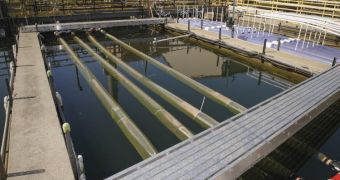Next month, NASA will transfer a unique floating algae cultivation system to the commercial sector. The technology could be used in conjunction with conventional methods at water treatment plants, and could address a number of environmental issues, in addition to facilitating the production of biofuels.
The Offshore Membrane Enclosure for Growing Algae (OMEGA) system fulfills a number of tasks, including growing freshwater algae, cleaning wastewater, capturing the dangerous greenhouse gas carbon dioxide, and producing feedstock that can be used in biofuel production.
The latter is of special interest to those in the industry, since current production methods require biofuel companies to compete with agriculture for water, fertilizer and land use. By employing OMEGA, this competition would disappear altogether.
Development of this technology is managed by scientists at the NASA Ames Research Center (ARC), in Moffett Field, California. Prototypes have already been installed at the California Fish and Game laboratory in Santa Cruz, and at the Southeast Wastewater Treatment facility, in San Francisco.
One of the main elements in the OMEGA system is a series of flexible plastic tubes, which ARC experts call photobioreactors. These tubes significantly promote the growth of freshwater algae.
As they grow, these organisms contribute to cleaning wastewater, while at the same time consuming carbon dioxide from the water, and replacing it with oxygen. Nutrients that would otherwise make their way into the world's oceans are the main source of food for these algae.
If OMEGA is employed at the large scale, the number and severity of oceanic dead zones – caused by saltwater algae consuming all oxygen from the water when exposed to high runoff nutrient concentrations – may decrease considerably.
Of the various types of algae that can be grown in this manner, some produce oil that can be turned into biofuels. The remains of these organisms can then be used to produce natural gas, fertilizers and feed. Studies have shown that deploying OMEGA does not hinder natural habitats.
“We have continuous video of various prototypes of photobioreactors, day and night, over a six-month period. We see birds and sea otters interacting with the system, but it does not impact their well being,” explains ARC OMEGA project scientist, Jonathan Trent.
“Preliminary data showed that the interactions of these animals are not problematic to the system or its functions,” the expert adds.

 14 DAY TRIAL //
14 DAY TRIAL //